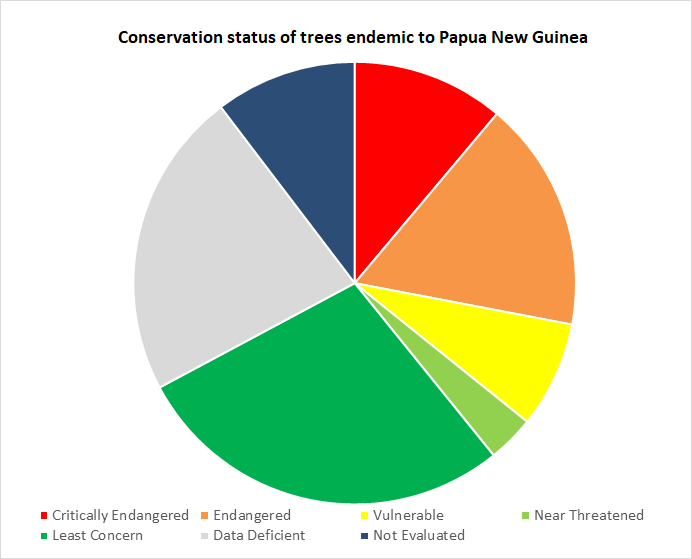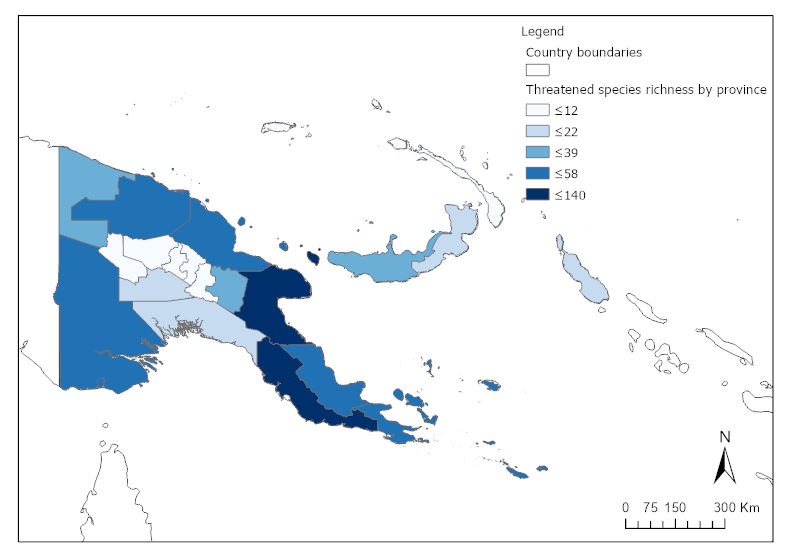Over 90% of Papua New Guinea's endemic tree flora assessed in latest IUCN Red List Update
-
Country
Papua New Guinea -
Region
Asia -
Programme
Global Tree Assessment -
Workstream
Saving Plants -
Topic
Conservation Prioritisation -
Type
News -
Source
BGCI
IUCN Red List of Threatened Species released a new update, including 1,104 new tree species assessments
News published: 12 December 2022
The IUCN Red List of Threatened Species released a new update, including 1,104 new tree species assessments. These tree Red List assessments all contribute to BGCI’s global initiative the Global Tree Assessment – assessing the conservation status of all the world’s tree species. As of today, the number of tree assessment available on the IUCN Red List is 38,256 assessments.
In the second update to the IUCN Red List in 2022, an over 100 new assessments for species native to Papua New Guinea were published. The Global Tree Assessment has been working with partners in Papua New Guinea since 2018 to complete assessments for the country’s large native tree flora, which includes over 1,200 endemic species. Now on the IUCN Red List 88% of native tree species have assessments and over 90% of endemic tree species are assessed.

The results of this assessment effort are documented in the latest paper released in Plants, People, Planet – Extinction risk to the endemic trees of Papua New Guinea written by Megan Barstow (BGCI), Tiberius Jimbo (Papua New Guinea Forest Research Institute – PNGFRI) and Katharine Davies (BGCI). This paper found that over 460 species of trees endemic to Papua New Guinea are assessed as Threatened, including 143 Critically Endangered, 217 Endangered and 100 Vulnerable species. The major threats are from conversion of lowland forest for agriculture (subsistence, small holder and agroindustry) and logging for timber. This aligns with the results from The State of The World’s Trees Report.
The paper also looked at the taxonomic and geographic diversity of the country’s tree flora. The provinces of Central and Morobe have many species recorded, a high number of which are threatened (Figure 2). In the Bismarck Archipelago and Bougainville, there is a low number of herbarium records and low species diversity. However, there is a greater proportion of threatened species present than in some parts of the mainland, for example, in highland provinces in the west of the country.

Taxonomically, similarly to global analysis of trees (Beech et al. 2017), Myrtaceae (149 species), Rubiaceae (131 species) and Lauraceae (120 species) are found to be the largest tree families and Syzygium (121 species), Cryptocarya (54 species) and Psychotria (47 species) are the largest tree genera. Of these Lauraceae and Cryptocarya are the most threatened, with over 90% of species at risk of extinction. There are eight families where 100% of the species are threatened, but these families represent only one or two endemic species. On the other hand, there are 18 families which currently include no threatened tree species.
Given the threats to endemic trees, it is important there is more consistent support and consolidated efforts to the protection of trees in Papua New Guinea. There are many opportunities for collaboration within country, internationally and with conservation agencies, which could be driven by all levels of society to protect trees. Suggestions towards conserving tree diversity in the country were given as follows:
- Establish in situ conservation areas for tree species.
- Generate information on endemic tree species.
- Engage society with endemic tree conservation.
- Restore and reinforce threatened tree populations.
Despite the tree diversity found in Papua New Guinea, it is rarely the focal point of conservation activities, and the GTA highlights why they need to be at the forefront of the conservation agenda. With the majority of forest cover still remaining in Papua New Guinea, it represents what is becoming an uncommon opportunity, to protect and save a staggering amount of tree diversity. Through the Global Tree Assessment, as with Papua New Guinea, we hope to understand more about the tree diversity in each country and it’s major threats. Through this data and knowledge gathering we can not only raise awareness for the conservation needs of trees but also mobilise action for those most threatened species. Assessing a country’s tree flora helps us towards providing a road map for the protection of tree diversity across the globe.
One example of this is the use of assessments completed through the Global Tree Assessment, is for prioritising and planning conservation action. In October, in collaboration with the IUCN SSC Conservation Planning Specialist Group and CSIR-Forestry Research Institute of Ghana, BGCI ran a conservation planning workshop for Ghana’s threatened trees. In the workshop key obstacles were identified and strategies for their effective conservation were explored. Through this process, participants were able to reach an agreement on which actions should be initiated and who should take the next steps towards implementing these recommendations.
Conservation Action Tracker
BGCI’s Conservation Action Tracker provides information on conservation actions for tree species.
Calling all Experts
As a membership benefit exclusively for BGCI Institutional Members, staff associated with these institutions can apply for inclusion in BGCI's Directory of Expertise.